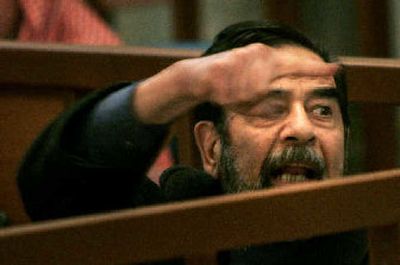Defiant Saddam lashes out in court

BAGHDAD, Iraq – Prosecutors produced documents and put former aides to Saddam Hussein on the stand Monday as they made their strongest attempt yet to link him directly to torture and executions.
The ousted president, who looked disheveled and appeared in his slippers, shouted “Down with Bush!”
Saddam’s half brother, Barzan Ibrahim – dressed only in an undershirt and long underwear – struggled with guards as he was pulled into the courtroom. Ibrahim, the former chief of intelligence, then sat on the floor with his back to the judge in protest for much of the session.
The defendants have rejected court-appointed attorneys named to replace their own lawyers who walked out of the trial last month and are demanding the removal of chief judge Rouf Abdel-Rahman. In Jordan, Saddam’s chief defense lawyer said there were no plans to end the boycott and denounced the court for forcing the former leader to attend.
“This is a cheap attitude,” Khaled al-Dulaimi told the Associated Press.
After the raucous start, prosecutors tried to prove Saddam’s role in a wave of arrests and executions that followed a 1982 attempt on his life in the Shiite village of Dujail.
Twenty-six prosecution witnesses have testified since the Saddam trial began Oct. 19, many providing accounts of torture and imprisonment in the crackdown, but they could not directly pin them on Saddam.
For the first time, the prosecution introduced documents and put two former members of Saddam’s regime on the stand. The witnesses included one of his closest aides, Ahmed Hussein Khudayer al-Samarrai, head of Saddam’s presidential office from 1984 to 1991 and then again from 1995 until Saddam’s ouster in 2003.
Screens in the courtroom, including the press gallery, showed a document in Arabic dated to 1984 allegedly written and signed by Saddam in which he ratified “the execution of the Dujail criminals.” A handwritten note at the bottom was allegedly by al-Samarrai.
Asked if the note was his handwriting, al-Samarrai, 62, said he could not be sure.
“I don’t remember,” he said. “I don’t remember anything at all.”
Another document shown in the court was a 1987 memo from the presidential office’s legal department saying two people sentenced to death in connection with Dujail had not been executed and suggesting that they be released because of old age and that those responsible for the “oversight” should be investigated.
Prosecutors have said that they had documents showing that Saddam was closely following the crackdown. Asked if he recognized the handwriting on the memo, al-Samarrai replied, “Mr. President.” That sparked a swift and angry correction from chief prosecutor Jaafar al-Moussawi and Abdel-Rahman, the chief judge. “Defendant Saddam Hussein,” they shot back.
Al-Samarrai insisted he knew nothing about the events in Dujail except what he said he had heard on foreign radio broadcasts.
“I am not fit to be a witness in this case,” he pleaded with Abdel-Rahman and al-Moussawi. “I don’t want to be a witness.”
Both al-Samarrai and the second witness, former intelligence official Hassan al-Obeidi, complained they too had been brought to the court against their will. Both are in custody in connection with other cases, according to al-Moussawi.
In Monday’s session, two judges sitting on each side of Abdel-Rahman read affidavits of 23 prosecution witnesses, with further accounts of imprisonment and torture in the crackdown.